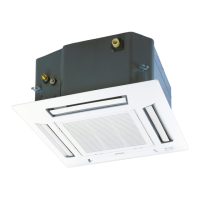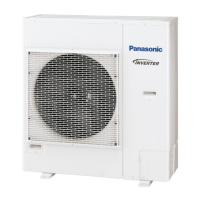Why does the outdoor unit of my Panasonic Air Conditioner emit water or steam?
- SsethrochaAug 26, 2025
The outdoor unit of your Panasonic Air Conditioner emits water or steam because condensation or evaporation occurs on the pipes.
Why does the outdoor unit of my Panasonic Air Conditioner emit water or steam?
The outdoor unit of your Panasonic Air Conditioner emits water or steam because condensation or evaporation occurs on the pipes.
Why does the POWER indicator blink on my Panasonic CU-4E23QBR Air Conditioner before turning it on?
The POWER indicator might blink before you switch on your Panasonic Air Conditioner because the unit is preparing for operation when the ON timer has been set.
What does it mean when the POWER indicator blinks and the indoor fan stops on my Panasonic Air Conditioner?
The POWER indicator blinking during operation with the indoor fan stopped indicates that your Panasonic Air Conditioner is in defrost mode. During this process, melted frost is being drained from the outdoor unit.
Why is the TIMER indicator always on in my Panasonic Air Conditioner?
The timer setting on your Panasonic Air Conditioner repeats daily once it has been initially set.
Why does my Panasonic CU-4E23QBR's outdoor unit emit water or steam?
The water or steam emitted from the outdoor unit of your Panasonic Air Conditioner is due to condensation or evaporation occurring on the pipes.
Why is the TIMER indicator always on for my Panasonic CU-4E23QBR Air Conditioner?
The TIMER indicator remains on because the timer setting repeats daily once it has been set.
How to improve the efficiency of HEAT/COOL mode on my Panasonic CU-4E23QBR?
If your Panasonic Air Conditioner's HEAT/COOL mode isn't working efficiently, make sure you've set the temperature correctly. Also, ensure all doors and windows are closed, clean or replace the filters, and clear any obstructions at the air inlet and outlet vents.
Why is the TIMER indicator always on on my Panasonic Air Conditioner?
The TIMER indicator on your Panasonic Air Conditioner remains on because the timer setting repeats daily once it has been set.
What to do if the Panasonic CU-4E23QBR Air Conditioner stops and the TIMER indicator is blinking?
If your Panasonic Air Conditioner unit stops and the TIMER indicator blinks, use the remote control to retrieve the error code.
What to do if my Panasonic CU-4E23QBR Air Conditioner does not receive the signal from the remote control?
If the Panasonic Air Conditioner unit is not receiving the signal from the remote control, ensure that the receiver is not obstructed. Note that certain fluorescent lights may interfere with the signal transmitter; consult an authorized dealer for assistance.
Instructions on how to prepare the remote control for operation, including opening the cover and setting the time.
Guides for starting/stopping the unit, selecting operation modes, and setting the desired temperature.
Explanation of warning symbols and general safety advice to prevent injury and property damage.
Safety guidelines for appliance use, supervision, cleaning, repair, and installation of units.
Precautions regarding power cords, outlets, grounding, and electrical hazards.
Cautions for unit cleaning, airflow obstruction, sharp parts, and installation environment.
Explains the remote control display and basic functions like temperature display units and default settings.
Guides on selecting operation modes (AUTO, HEAT, COOL, DRY) and adjusting fan speed.
Information for users on the proper collection and disposal of old electrical equipment.
Instructions for setting daily ON/OFF timers to control the air conditioner's operation schedule.
Guides on setting up to six weekly programmes for automated operation and energy saving.
Lists common occurrences that are not actual malfunctions, along with their causes.
Provides steps to check before contacting a service professional for operational issues.
Explains how to identify malfunctions and retrieve error codes using the remote control.
Instructions on how to prepare the remote control for operation, including opening the cover and setting the time.
Guides for starting/stopping the unit, selecting operation modes, and setting the desired temperature.
Explanation of warning symbols and general safety advice to prevent injury and property damage.
Safety guidelines for appliance use, supervision, cleaning, repair, and installation of units.
Precautions regarding power cords, outlets, grounding, and electrical hazards.
Cautions for unit cleaning, airflow obstruction, sharp parts, and installation environment.
Explains the remote control display and basic functions like temperature display units and default settings.
Guides on selecting operation modes (AUTO, HEAT, COOL, DRY) and adjusting fan speed.
Information for users on the proper collection and disposal of old electrical equipment.
Instructions for setting daily ON/OFF timers to control the air conditioner's operation schedule.
Guides on setting up to six weekly programmes for automated operation and energy saving.
Lists common occurrences that are not actual malfunctions, along with their causes.
Provides steps to check before contacting a service professional for operational issues.
Explains how to identify malfunctions and retrieve error codes using the remote control.
This document is an operating manual for Panasonic Air Conditioners, covering both single-split and multi-split systems.
The Panasonic Air Conditioner is designed to provide cooling, heating, and dehumidification for indoor environments. It supports both single-split configurations, where one indoor unit connects to one outdoor unit, and multi-split systems, allowing multiple indoor units to connect to a single outdoor unit.
In a multi-split system, indoor units can be operated individually or simultaneously. The system prioritizes the operation of the first unit turned on. It's important to note that HEAT and COOL modes cannot be active simultaneously for different indoor units in a multi-split setup. If an indoor unit is standing by for a different operation mode, its power indicator will blink.
The air conditioner offers several operation modes:
Additional features include:
The remote control allows users to:
The manual provides operating conditions based on Dry Bulb Temperature (DBT) and Wet Bulb Temperature (WBT) for both indoor and outdoor units across different models and modes.
Single Split Models (CU-E12QD3R, CU-E18QD3R):
Multi Split Outdoor Units (CU-4E23QBR, CU-4E27QBR, CU-5E34QBR):
The remote control temperature setting range is 16 °C to 30 °C.
The air conditioner is operated primarily via a remote control.
Regular maintenance is crucial for optimal performance and longevity of the unit.
Safety Precautions: The manual emphasizes safety, categorizing warnings into "WARNING" (risk of death or serious injury) and "CAUTION" (risk of injury or property damage). Prohibited actions include using modified cords, installing in explosive atmospheres, inserting objects into the unit, touching the outdoor unit during lightning, direct exposure to cold air, or sitting/stepping on the unit. Compulsory actions include consulting authorized dealers for cleaning/repair/installation, confirming refrigerant type, earthing the equipment, and switching off power before cleaning or during non-use/lightning activity.
| Brand | Panasonic |
|---|---|
| Model | CU-4E23QBR |
| Category | Air Conditioner |
| Language | English |












